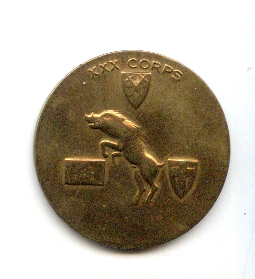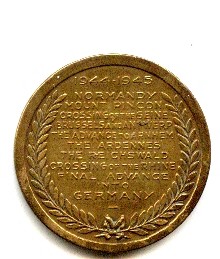The Coleraine
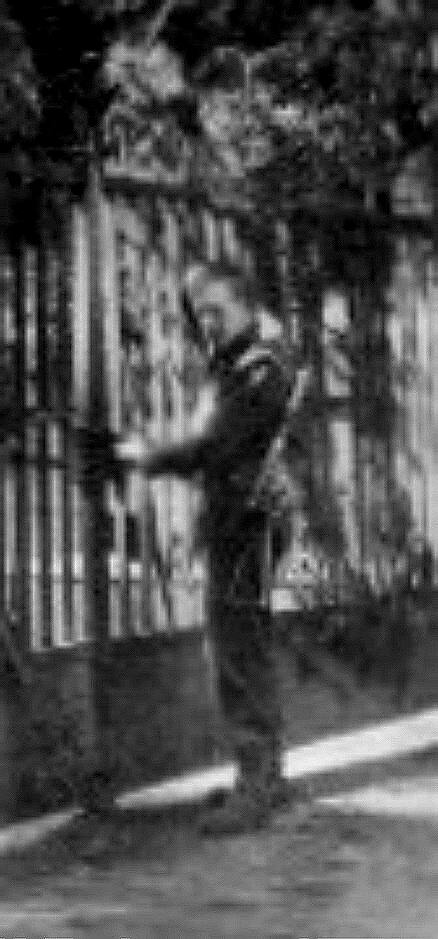
1939 - 1945
The Advance to
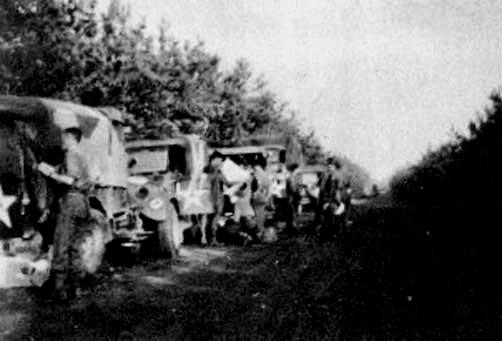
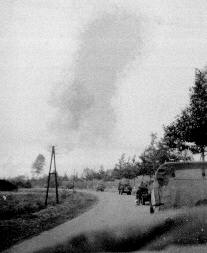
The Battery held up on the road to Nijmegan with smoke going up from the battle ahead
After Eindhoven the Battery moved on to Grave,
Neerbosch and Nijmegan. The Nijmegan bridge had already been taken by 82nd
American Airborne. With the temporary German hold-up overcome, the
The Nijmegan Bridge The Battery were all posted to gun pits at the Nijmegan Bridge area on September 17 1944. That was an easy date to remember because it was the day I met my future wife. Ernie Piney and myself thought we would go out and scout around the vicinity of the gun pit that evening after we settled in. This was something we always did on being posted to a new location. You had to know the area you were operating from and make sure you knew all the escape routes should you come under attack. There were a few Dutch farms near our location so we approached the nearest one. A figure came out of the shadows and I covered him with my S&W 38. He said "Its all right Tommy....friend". This man was an ex-Dutch Marine who had served in the Dutch East Indies. He took us to the farm and introduced us to the farmer, Mr. Brickmann, his wife and two daughters. It was not long before the farmer was bartering with us for army rations and stores in exchange for fresh farm produce. We had soap, sugar, flour, and powdered milk. He had chickens and vegetables.
Then the ex-Marine asked us if we would like to meet his family. We said, "Yes, certainly" and he introduced us to his terrified wife, God rest her, and Trude, his daughter. They were living in the cow stalls on clean straw. All their belongings were wrapped up in blankets. The family home was in Maas Stradt, Nijmegan only 100 yards from the Nijmegan Bridge. They had to evacuate their home when the fighting had started a week previous.
Trude also had two brothers, two beautiful big blokes, big hard men. At the start of the invasion the Germans had lifted them. They were taken for a period of forced labour. This was a good thing in a way because they could have been taken to a Concentration Camp. As forced labour they had to be fed to a certain degree. But they survived, working in the Ruhr at armaments.
Two weeks after our arrival it had settled down a bit so we borrowed a lorry and moved the family back to Maas Stradt. Because the weather was so bad, we loaned the family our gas capes to keep them dry for the journey home. They were lucky, despite the fighting around the bridges, their home was intact. It was on that day we heard the German ME 109 and 262's
The British may have invented the jet engine but it was the Germans who got the combat jet plane in the air first. We could not touch these planes. With the piston engined planes all you had to do on hearing them approach was to close your eyes and turn your face in the general direction of the sound. This was 90% accurate for getting the gun on to a plane. With the ME 109 and 262's this was impossible. All you heard was a "whooshing" well after the jet had passed your location. We had achieved air supremacy in Europe but it did not feel like it when the ME's hedge hopped over your location.
Anyway, a week after we had dropped off the family, Ernie Piney said to me, "Trude is here with the gas capes". Her mum and dad invited us back to their home for a cup of coffee. This happened quite often and during these quiet interludes Trude and I were teaching each other our language. We were having coffee one day and I said to Trude in perfect English, "Will you marry me?" To my total surprise she understood me and immediately said "Yes". The wedding took place ten months later on July 18 1945". Spanky McGowan (2004)
The Road to Arnhem The road was narrow and built up on marshy ground. What was happening was this, a tank would go forward on the road to Arnhem, the Germans would knock it out, we would shunt the tank into the swamp and push the next tank forward, an impossible situation. If this had been any other country in the world, we would have punched through to the Arnhem Bridge, the terrain beat us. It was also a wet winter. If it had been a snowy winter with ice on the ground, the Allies might have got through to the Airborne.
|
The Hanny Walker Story
My name was Johahna van-Haarlem. It was September 1945 and our family lived at Frans. Halsstrhat 75 Nijmegan. Just after the German occupation, father and the local men had been taken by the Germans and used as slave labour on building the Siegfried Line
I witnessed the airborne troops being dropped from their planes. The sky was full of parachutes. It was terribly sad to see because the Germans were shooting the paratroops as they descended.
Food was scarce. On 17th September 19444, my brother Peter and I cycled to a farm to see if we could get any food. We usually bartered with the farmers for our food at that time. The farmer refused to barter because the area was surrounded by soldiers.
Peter and I left the farm to go home. At this stage we were under observation from Norman Walker and his gun crew. Norman sent one of his men over to the farmer. The gunner gave the farmer a packet of cigarettes, it was Gallagher’s Blue. The farmer gave the gunner half a bag of potatoes and half a bag of carrots. Then Norman called us over to his gun. We did not speak each others language but he ended up giving us the two half bags of vegetables. We thanked Norman and made our way back home.
Sgt Norman Walker and Gun Crew 1945
When we arrived home my mother said we were covered in mud. There had been a lot of rain in October. The soldiers were also covered in mud due to the continuation of the bad weather. Mother suggested that we must return to the gun crew the next day and ask them if they would like to come back to our house.
Norman used to bring at least four different men back to our house every night. There they were able to sit down and write letters home and relax away from the mud and rain. But the Americans needed help in the Ardennes. The Battery had to pack up before Christmas and headed off.
Around January 1945 there was a knock on the door and we could not believe our eyes. There stood Norman Walker and his friend Sammy Nevin from Portrush. The Ardennes had been sorted out and the pair of them used to borrow a motorbike and ride the 120 miles from the Ardennes to our home in Nijmegan.
One night they were riding along and Norman noticed that there were strands of white tape across his chest. He had driven into a mine field. Sammy Nevin slid himself off the rear of the bike into the tyre tracks and pulled the bike backwards. Then Norman got off at the front and they pushed and pulled the bike back along the tyre tracks until they were clear of the mine field.
That year, 1945, Norman asked me to marry him. My father said, “Well, if you really love her you will have to come back for her. You will not marry her until her next birthday in October 1946”. Norman was demobilized in 1945 and went home with the Battery.
Norman returned to Nijmegan again on 1st October 1946 which was his birthday. My birthday was 8th October. At the time we married we could not speak each others language, but we managed. After we were married we both came back to Coleraine and never regretted a moment of our lives together.
|
The Ardennes "At Nijmegan we were all getting ready to celebrate Christmas, the war was practically won at this stage, or so we thought. Trude, her father and mother and the gun crew were clubbing together to have a good Christmas. The cook, Marcus Wilton had been scalded when the stove exploded, other than that we had no serious problems.
About the 19th Dec 1944, Willie Watton, the Don R (Dispatch Rider) came up to us. He told us
to pack up as we had one hour to
move. We told him to go away. This information was hard to believe. The reason
was that Von Runstedt went through the Yanks in the
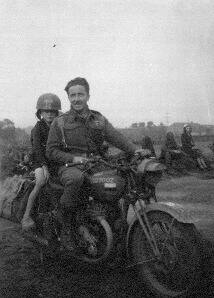
Willie Watton
By
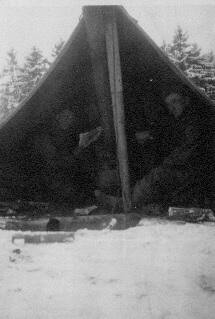

Willie Reid and Jigger Diamond ------Willie Reid and J Hamill

The Battle of the Bulge - Belgium - 16 Dec 1944 until 16 Jan 1945
The Germans launched the Ardennes Offensive on 16 Dec 1944. The Start Line for this offensive was sixty miles long. It ran along the German border from Monschau in the North to the southern part of the Luxembourg/German border in the South.
The German aim was to punch their way through the weak defences in the Ardennes, cross the River Meuse and take the port of Antwerp. This would sever, not only the Allied supply lines but also the Allied Armies. With this successful conclusion, the German armies intended launching an attack on their Eastern Front. By 18 December, 28th and 106th American Divisions had been overrun. The main reasons for this success included the fact that 106 Division were spread out over a twenty one mile defensive front as opposed to the normal five mile defensive front. Sgt J Kline 106 Div (1996)
On 19th December, 6th LAA Battery were ordered to move from Nijmegan. Initially the Battery were located at Hasselt along with 30 Corps who covered the Northern Line from Louvaine to Hasselt. There they were expected to halt the advancing German Armies. American 1st Army were located from Ciney to Duboy and 3rd Army were located south at Bastogne.
However, due to the valiant and tenacious fighting of the re-grouped American Armies, the German Armies were halted on 22 December. This allowed the Allied forces to be re-deployed. On 23rd December, 6th LAA Battery, under the command of 6th Airborne Division moved to Namur and operated along a line from Ciney to Dinant. (Doherty, 1988)
The Bulge, which delineated the successful containment of the German offensive, was fan shaped. The Front extended for sixty miles from Monschau in the East to Dinant in the West. The base of the fan shape was thirty miles south on the Luxembourg/German border.
By the end of January, the German Armies had been routed. Of the 500,000 Germans involved 100,000 were casualties. For the Americans 600,000 were involved and they had 81,000 casualties. The remaining Allied Armies lost 1,400 from the 55,000 involved.
The
The Reichswald Forest lies 10 miles south east of Nijmegan between the River Rhine to the East and the River Meuse to the West. The forest also located the start line of the trench system known as the Siegfried Line. From both sides of the forest, the two lines of trenches ran parallel to the rivers. When Holland was first invaded many of the male population were forced to labour on the Sigfried Line.
"The Germans had been well dug in with underground bunkers containing two or three beds. When 82nd Airborne captured the Nijmegan bridge, the Germans abandoned the forest and left all their equipment behind.
The Dutch had very little in the way of material goods. The Germans had occupied the Netherlands since 1940 and virtually stripped it to the bone. We took a 15cwt truck, loaded it up with German stores and took it into Nijmegan on a regular basis". (Anon)
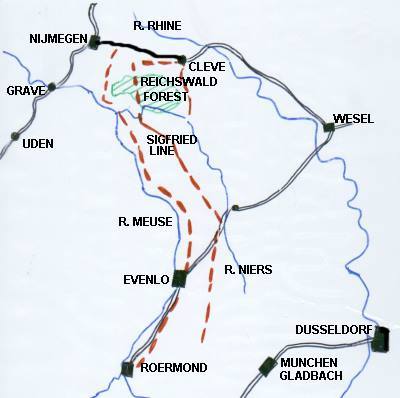
Crossing The Rhine The
"At the
The Battery had the first gun across the
"After crossing the Wesel, we stopped at the

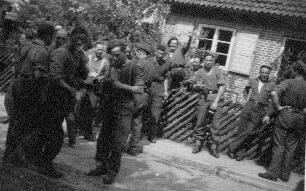
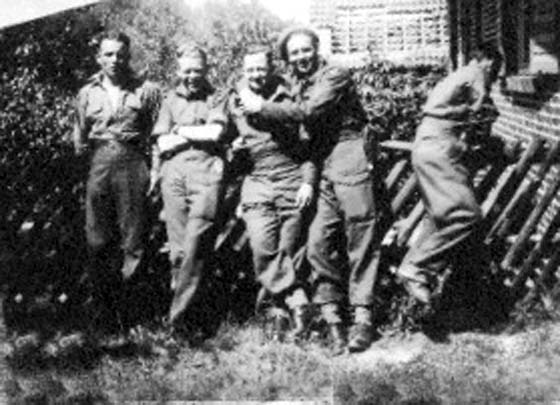
Photo 1. Spankey on the Barrel
Photo 2. The
Photo 3. Blinkie Gamble, Allen Thompson, Frankie Walls, Allen Elliot and finally, Bob McVeigh sick as a fart on German wine.
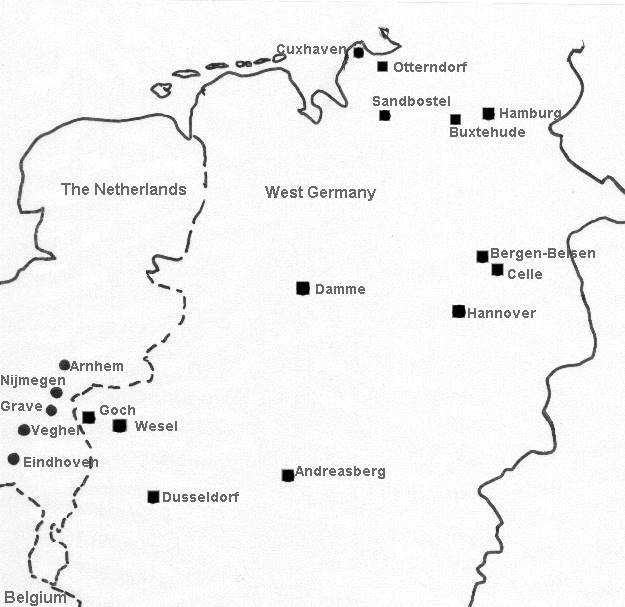
The Final Advance into

Willie Heward
St. Helens Merseyside
Willie 'Wind' Heward never stopped talking. When he was guarding a 3 Acre German Munitions Dump at Buxtehude he had an accident with his Sten gun. The gun dropped off his shoulder and a round discharged into the back of his head. He lived. Then the Battery went on to carry out guard duties at Stalag XB, Belsen and Sanbostel Concentration Camps.
"The Battery carried out security duties at
After the horrors of Belsen and San Bostel, the Battery moved to
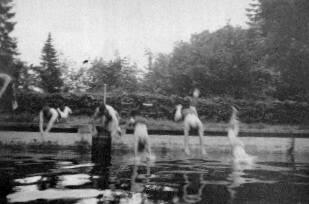
Spanky
left the Hartz mountains to marry his wartime
sweetheart
Finally, the Battery was posted to Cuxhaven
for Dockyard duties. For the
30 Corps
Commemorative Medallion
